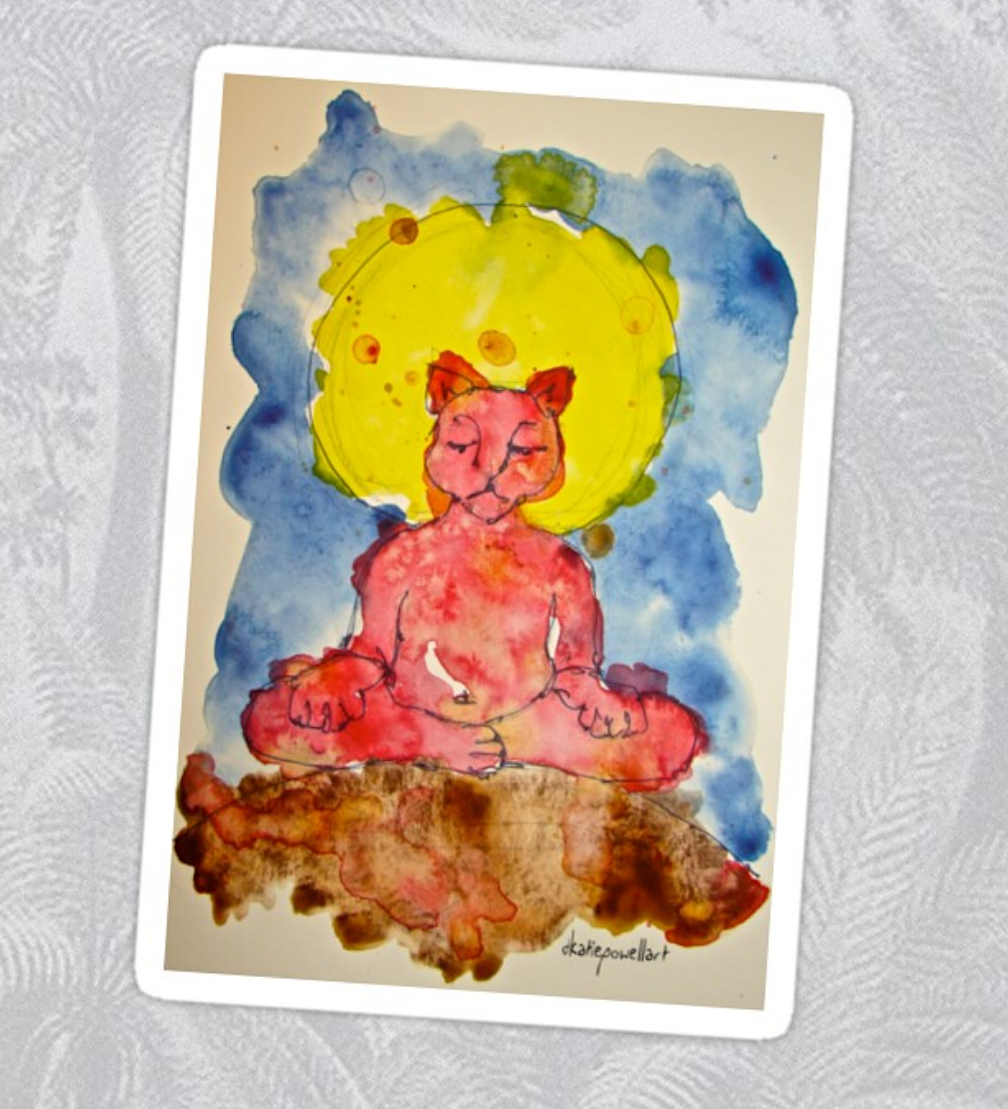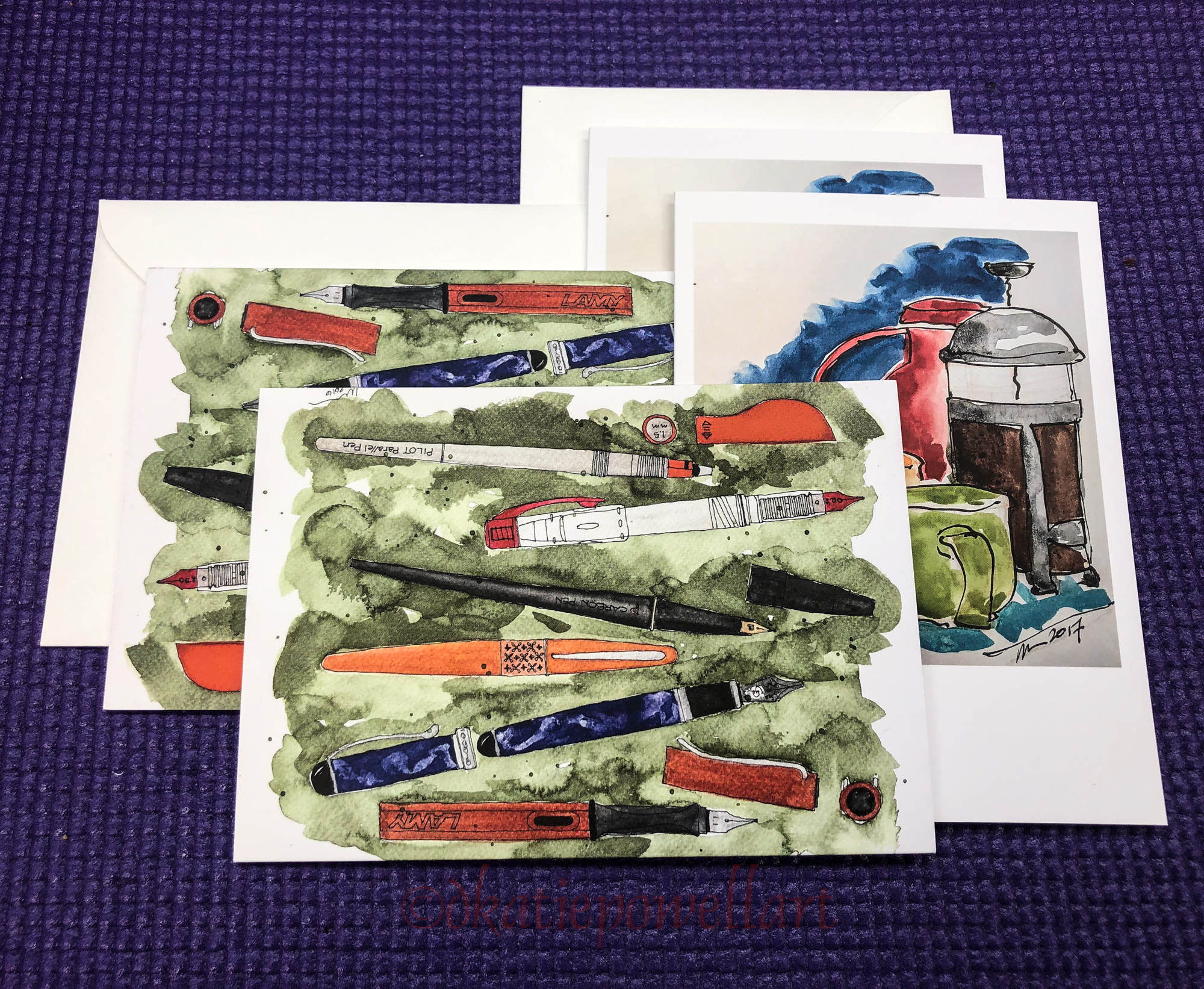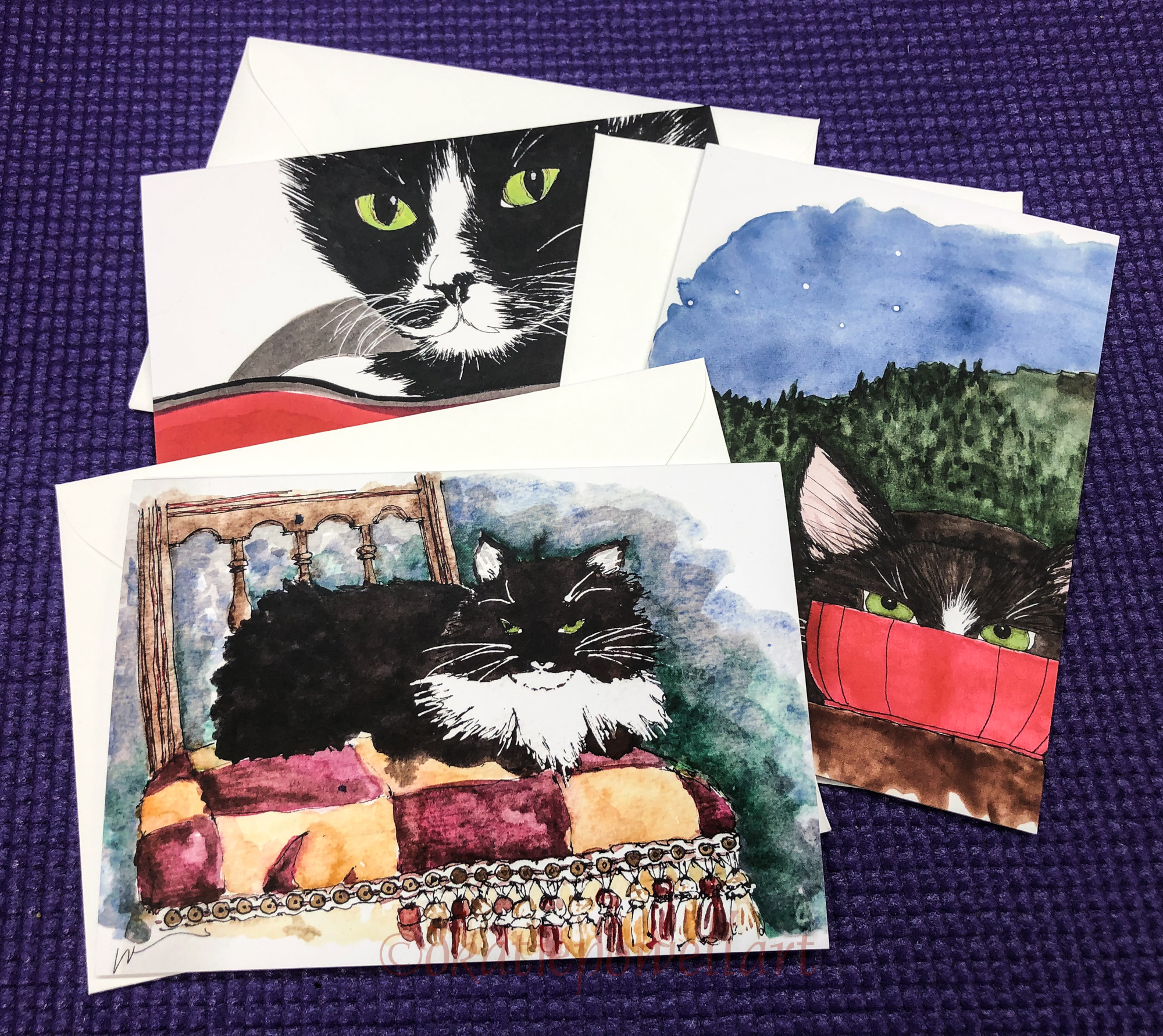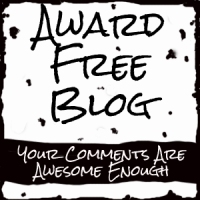 I’m taking an online course right now
I’m taking an online course right now
from another architect turned artist.
This artist is quite protective about her coursework staying within students,
so I hesitate to discuss her by name.
As our drawing styles are similar,
I am taking the course primarily
to learn tips she may have to laying
down watercolors quickly on location.
Anyone who follows my blog knows
I am a proficient acrylic artist, and
switched to watercolors this year.
Watercolors are a whole other world,
very be-here-now in their nature,
and I am just beginning to get the
hang of them. One thing I have observed in my own work as I’ve progressed, is that the best work is when I have little time and
just do it quickly without thinking too much,
and without fussing over the details.
It’s a one-stroke mentality, and I like it!
That said, I noticed that most of the architects-turned-watercolorists appear to use pencil to lay in some guidelines or the basic form of the sketch before laying in ink or color.
Yet especially with many Urban Sketchers and art journalers, that is a bit like admitting you are a cheater. As an architect, I learned to use a pencil proficiently, especially to lay in guidelines. I used the entire range of pencil types, hard to soft to blue, and had no idea that anyone did this any differently until I met watercolorists! In this class I am taking, much of what is being taught is old news for me. That doesn’t mean I have not learned anything — I can always learn something from a teacher, even if it through sharing!
 A lot of people have trouble with circles, ellipses, and even squares.
A lot of people have trouble with circles, ellipses, and even squares.
(Five minute freehand wonky drawing / watercolor above.)
When I was a young architect, I practiced drawing grids during lectures
(when I was not doodling stars) and this was a good thing because I was able to
freehand at 1/4-inch with no problem by the time I was out of college.
I had been an advanced draughtswomen for seven years, and had the many-hours-daily practice of circles, triangles, perfect squares, and endless grids paid off.
By the time I was working as a corporate architect, I could freehand about 20,000 sf and not be off by more than a foot or two in any direction. This tool came in handy when dealing with clients, which allowed me into the conference room doors to do just that — design with the clients, instead of being relegated to drawing details for someone else.
What is the point of all this? When an art teacher tells you to practice, PRACTICE!
If you are in a meeting, draw circles and then more circles. Take gridded paper with you to meetings and appointments and draw over the lines until your hand-to-eye coordination can do it in your sleep, then do it without the gridded paper.
 This morning I knocked out a quick sketch to satisfy the class requirement. To make it more interesting, I timed each phase to see how long I took.
This morning I knocked out a quick sketch to satisfy the class requirement. To make it more interesting, I timed each phase to see how long I took.
I learned something. With the distraction of holding a morning cat in my arms, the pencil sketch took a minute, maybe two. My Lamy Safari pen still is not working as smoothly as my cheap Preppie pens, and so that slowed me down — but that phase only took six minutes. I rushed the watercolors because I had a blog to post (not this one) and while I
wished I had waited a bit longer on drying the paints — the colors ran — I finished the watercolor in under fifteen minutes. WOW! I said to the only living being up with me at 5am, my cat. Maybe I am faster than I thought!
Next goal, to get the hang of watercolor juicy washes and finding that just-right mix
of water-to-color ratio so that I don’t get puddles (see the rings around some of the
color in the detail image?) but instead lay in a nice just-right density of pigment.
And shadows. I need to turn off the overhead fluorescent lights and paint shadows!
Drawn in an Stillman & Birn Alpha journal (sorry but I am not a fan of the small journal, which just doesn’t lay flat enough for me, and that is what I wrote in one of these pages — but I love Stillman & Birn). A Caran D’ache watercolor pencil followed by Lamy Safari pen with Noodler’s Polar Brown ink, and Daniel Smith and QoR watercolors.
I agree to Creative Commons Attribution-Non-Commercial 4.0 International License, which you can learn more about by visiting the site, or,
visit my web page for a more user-friendly summary on my terms.
My images/blog posts may be reposted; please link back to dkatiepowellart.























Great info – especially to be reminded – again – that those of you I view as very talented have been PRACTICING for years!! Two of my recent tangles were done in circle figures (a snowman and Russian doll( and as I drew the figures “I need to PRACTICE” was in my head! Now I will hear you instead of my monkey mind. Much preferable 😊
LikeLike
Do I have a high squeaky voice?
LikeLike
No you are more like Lauren Bacall .
LikeLike
Oh I LOVE that!
LikeLiked by 1 person
I use pencil all the time… i can’t shake years of art school where we were taught to use pencil guidelines to block in shapes and check proportions… the only change is i use some light shade watercolour pencils sometimes now… I hate the whole snobbery of using pen only… I sort of feel like it is a bit ridiculous… sometimes I use just pen and others pencil as well, but what is the big deal… as long as you are drawing and painting who cares right… I do love your drawing style and am starting to explore more architectural drawing myself… find it fascinating…xx
LikeLike
My favorite drawing teacher of all time for architectural drawing is Frank Ching (Seattle). If you want me to look at which book is the best (he has so many that relate better to architects themselves) I can look it up — message me! Rebel with a cause here thinks that ALL rules are dufus-headed! That is a technical term, BTW.
Anyone who reads this go visit Tracey’s blog — I never miss it!!!!
LikeLike
Hi Kate,
I am collecting definitions of what ‘practice’ actually means when it comes to art. Thankyou for yours. And I love pencil and watercolour together. Before I began the course I had been reading art books for two years, so know a lot of theory. Most of the theory in the course is the same. However I never, ever came across anything in books about the inferiority of a graphite pencil in planning out a painting, be it in a sketchbook or a full size production. Some artists even use pencil as part of their finished painting – for instance Judi whitton, Charles Reid, and Alwyn and June Crawshaw. I don’t know if any of these artists were architect-trained. Their book jackets do not imply this. Watercolour and graphite – their stuff is beautiful.
For actual sketchbook examples there are John Lidzey and Malcolm Carver. Lidzey was originally a teacher in typographic and graphic design. Carver was an architect. Neither succumbed to the idea that ink was better than graphite. Their sketchbooks sport double page spreads of beautiful water colour and pencil sketches. Lidzey used to add pencil over the top of his watercolours for additional dark tones. Lidzey is no longer with us but he did write a few books. I like his “Watercolour Workshop” published by Collins. In it are some of his sketchbook examples.
Carver does a lot of travel sketching on location. If you google “Malcolm Carver” there are several pdf versions of published magazine articles on his website. The one titled “The Art of Travel Sketching” shows how Carver lays down a detailed loose pencil drawing to begin with, then the watercolour is slooshed over the top but still allowing the pencil lines to show through. Carver answers emails.
I also would love to know your recommendations of books by Ching. Thankyou. Sandi.
LikeLike
Sandi I think I ma going to write a post sometime soon about my favorite drawing books, especially as what is currently the rage are often knockoffs or watered down versions of some really great books. Ching’s are, of course, geared to architecture, since he taught architectural drawing and design in Washington. I think the best book for the non-architect would be Drawing: A Creative Process — though there is a good deal about architecture in that one too. If you want a good book on architectural concepts, look at Form, Space and Order . . .
There is a lot of chatter about no-pencil in sketching circles. I don’t know how it got started. Even a currently “hot” school has many teachers that say NO PENCIL. And I think it is crazy. However, I do think that Brenda Swensen’s 75-day challenge using no pencil or watercolor, just pen drawing is a good exercise — moves those addicted to erasers away from them, and you become bolder.
I can’t wait until the day you decide to stop being a theorist and come out of the closet. You must email me a drawing!
Thank you for the suggestions, I am googling them now!
LikeLike
Malcolm Carver’s outdoor sketching kit is so tiny, isn’t it. Thankyou for the suggestion about Ching’s books. It’s helpful to have an independent opinion. I have purchased his “Drawing: a Creative Process” online. The copy was extremely inexpensive and I’m sure it will be an asset for my drawing practice. I’m able to access Ching’s other books at university libraries here.
Thankyou for this very interesting discussion. Sandi
LikeLike
That was the one I would recommend now. And look for his blog — he is in Seattle.
LikeLike
Hi Kate,
Re your last message below: Thankyou, I didn’t think to look up Ching on the internet. I found his truly interesting blog and popped him on my task bar along with Tom Hoffmann, whose book I have just picked up from the library today. I like Hoffmann’s blog, and his book, because he teaches watercolour using examples by other artists as well as his own, and I feel he analyzes in an interesting way. Tom Hoffmann is in Seattle as well. They make good artists and teachers in Seattle 🙂
LikeLike
Actually your ‘last message’ is above. I am still not conversant with the order in which a comment will be posted on blogs. But I will learn.
LikeLike
Sandi I also can’t figure out how they put the orders down! Make sure I get to see your first images you post — anywhere!
LikeLike
Oh yes, and I will be visiting Tracey’s blog too.
LikeLike
I usually use pencil for planning a composition. This allows me to treat outlines more sensitively or enables the use only tone or colour to define shapes and form. Pencil is a very useful design tool, and sometimes I use pencil when sketching, and finish with pen or water color in the comfort of my studio.
On the other hand, I abandon pencil and draw directly with the pen to obtain a free, gestural feeling for life drawing. This maintains all the sketchy lines and produces a work with lots of expression. I do not think that pencil is a crutch for artists with poor drawing skills, but a tool to be used at the discression of the artist to create a desired effect.
LikeLike
Hi Cojo —
I agree. I also found it a useful practice to spend some time drawing with ho pencil, just pen — and found a freedom in that nowness! Tell me if you have a blog — Love to see your work!
Kate c
LikeLike